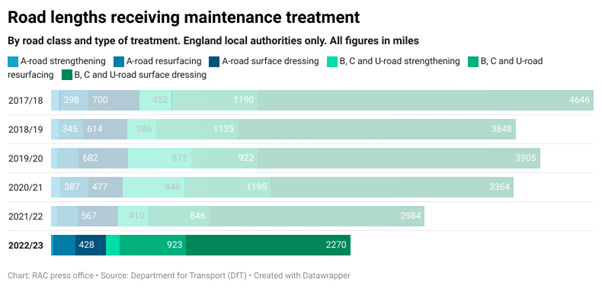Road maintenance conducted by councils across England has fallen by almost half (45%) in 2022/23 compared to five years ago.
That’s according to new analysis of Government statistics by the RAC, which shows that the fall resulted in 3,366 fewer miles receiving any kind of improvement work in the last financial year.
The figures reveal that 764 miles of A roads were strengthened, resurfaced or preserved, a 37% decrease (458 miles) from 1,222 in 2017/2018.
For minor roads listed as B, C, and unclassified, work was carried out on 3,380 miles of road in the past financial year compared to 6,288 five years before, a drop of 46% (2,908 miles).
Furthermore, with fleets regularly having to deal with pothole-related damage to cars and vans, just 4% of the 17,853 miles of A roads maintained by councils in England were resurfaced or given life-extending preservation treatment in 2022/23.
RAC head of policy Simon Williams said: “These figures lay bare just how little resurfacing and life-extending preservation work councils have managed to carry out in the last financial year.
“We suspect this means road maintenance in England has reached a new low point – a sorry state of affairs considering how car-dependent the country is.
“It’s especially concerning to see that so few miles of A roads received any form of road maintenance last year when these important routes are used by millions of drivers every day.
“Meanwhile, our minor roads that are essential in connecting rural areas have received barely a crumb of the pie.”
Looking at specific types of road maintenance, 1,223 miles of all road types were entirely resurfaced by councils: a small 9% increase on 2021/22, but 22% fewer than six years ago.
Meanwhile preservation treatments – such as surface dressing and micro surfacing used to extend the life of roads – fell to their lowest level in five years.
Just 2,698 miles of roads were given preservation treatment in the last financial year, a 50% dip on the 5,345 miles treated five years ago and a 25% drop year-on-year compared to 2021/22.
Regionally, more than a third (35%) of the 158 roads authorities in the latest data failed to carry out any road surfacing while six-in-10 (61%) did no preservation maintenance work at all.
Over the past 12 months, the average length of roads resurfaced for all authorities was just 17 miles and 28 miles for preservation work.
For two years running, Kent resurfaced the most miles of A roads out of all authorities: 26 miles of its 502 mile-network (5%), three miles less than the 29 it completed last year. Meanwhile, Staffordshire carried out the most amount of preservation work, treating 36 miles of its 412 miles of A roads (9%).
Moving southwest, Gloucestershire topped the tables for the highest number of minor roads resurfaced by replacing 64 miles of its 3,066-mile network (just 2%), while in the East, Norfolk completed the most preservation work by treating 251 miles of 5,573 roads (4.5%).
But the highest percentage of roads were treated in the West Midlands, with Telford and Wrekin resurfacing 18% (nine miles) of its 52-mile network and Sandwell carrying out preservation treatment on 13% (seven miles) of its 54-mile network.
The analysis follows a pre-Christmas period pockmarked with road defects for RAC patrols who attended the highest number of pothole-related breakdowns in any fourth quarter since 2019.
It also comes in the wake of the Government announcing its ‘biggest ever’ road resurfacing programme to improve local roads plagued by potholes.
The Department for Transport (DfT) allocated £8.3 billion of funds in November, which it says have been redirected from the cancelled phase 2 part of HS2, enough to resurface more than 5,000 miles of road across the country over the next 11 years.
However, the Asphalt Industry Alliance (AIA) has previously reported that, while half (51%) of local roads are in good structural condition, the remainder - more than 100,000 miles - could continue to deteriorate to the point of needing to be rebuilt within the next 15 years, without appropriate maintenance measures.
RAC garage data from December 2023 shows that for anything more serious than a puncture, it can cost up to £460 a car needs to go to a garage after hitting a pothole.
Williams continued: “Highways authorities need to take a ‘traffic light’ approach to road maintenance.
“Roads in ‘green’ and ‘amber’ conditions should undergo preventative maintenance by filling potholes and carrying out the most appropriate surface dressing treatment between April and September. This will seal the roads against water and prevent cracking in the cold winter months.
“Roads deemed to be in ‘red’ condition need to be fully resurfaced, or strengthened, as no amount of preventative treatment will stop them from falling apart.”
With road maintenance levels taking a nose-dive, it’s no surprise the RAC’s Pothole Index has got worse recently with drivers now nearly twice as likely to suffer a pothole-related breakdown than they were in 2006.
“That’s why the Government’s £8.3bn cash injection over 11 years still isn’t nearly enough for a long-term fix,” said Williams.
“We believe a proportion of money raised through fuel duty should be ringfenced to give councils the certainty of additional dedicated roads maintenance funding for years to come.
“Otherwise, this serious, decades-long problem will continue, meaning more roads will literally crumble away. The longer this is left unaddressed, the bigger the eventual bill for councils.”

To help highways authorities monitor as many road surface defects as possible, the RAC has partnered with technology company Metricell to encourage drivers to use Stan, a free mobile app that collects data on the state of UK roads and engages local authorities to fix the issues.
After downloading Stan, users can report a road defect by taking a photo or video with their smartphone, only if it’s safe to do so when the car is at a complete stop.
The app uses AI to identify the defect which feeds into a national road map of surface issues on the RAC and Stan websites.






















Login to comment
Comments
No comments have been made yet.